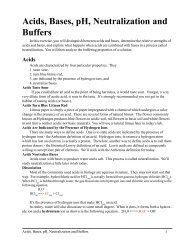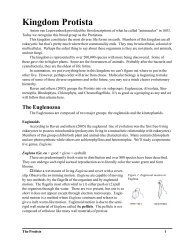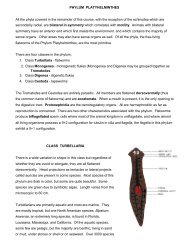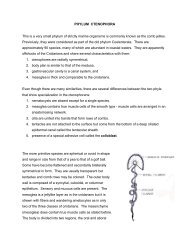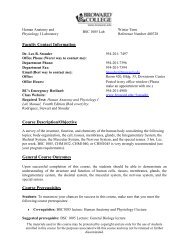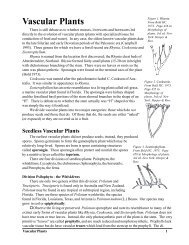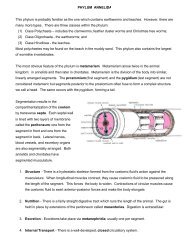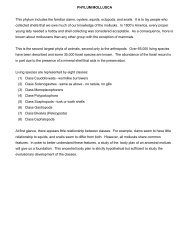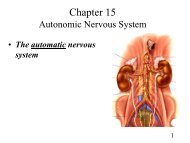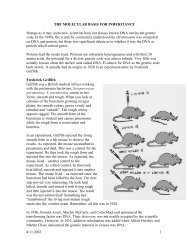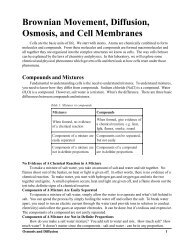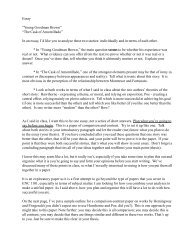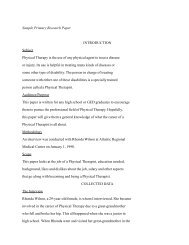Meiosis
Meiosis
Meiosis
Create successful ePaper yourself
Turn your PDF publications into a flip-book with our unique Google optimized e-Paper software.
Crossing OverAfter homologous chromosomes pair up,crossing over may take place (see figure 5). This iswhen one of the “arms” of the chromosomes crossesover another “arm” of the homologous chromosomeor the arm of an exact copy. The chromosomes maybreak apart and rejoin. In some cases, no changetakes place. However, if one arm of a chromosomehas a gene for “Z” and the homolog has an allele for“z”, when the arms cross over, break apart andfigure 6. chiasmata.figure 5. crossing over.rejoin, the chromosome’s gene maynow read “z” and the homolog’s allelemay now read “Z”. They have tradedgenes.When looking at chromosomesunder the microscope, you can seethese cross over points. The crossover point is called chiasma (chiasmata,plural). See figure 6. The closer genes are on chromosomes, the less likely a cross over willoccur. The farther two genes are apart on a chromosome, the greater the chance of cross over.Metaphase IThe events of metaphase I of meiosis are exactly thesame as the events of metaphase of mitosis. The chromosomesalign themselves along the equatorial plane of thespindle.figure 7. anaphase I, the centromeresdon’t divide; homologs push apart.Anaphase IIn anaphase I of meiosis, the centromeres do notdivide. Instead, homologous chromosomes push apart.Telophase IDuring telophase I of meiosis, the chromosomesreach the poles, they uncoil, and nuclear membranes form. This is exactly the same as telophase ofmitosis.Cytokinesis IThis is exactly the same as cytokinesis in mitosis. Just remember, homologous chromosomes arenow in individual cells.Prophase IIProphase II of meiosis is the same as prophase of mitosis. There is no synapsis and crossingover since homologous chromosomes are now in separate cells.Metaphase IIThis is the same as metaphase I or meiosis and metaphase of mitosis.<strong>Meiosis</strong> 3
Anaphase IIHere, the centromeresdo divide and individualchromosomes push apart.It’s exactly the same asmetaphase of mitosis.figure 8. anaphase II, centromeres divide and chromosomes push apart.Telophase IIThis is the same astelophase I of meiosis andtelophase of mitosis.Cytokinesis IIThis is the same as before.We have just had two successive divisions of the nucleus where the chromosomes duplicatethemselves only once!SpermatogenesisSpermatogenesis (see figure 9)begins with a spermatogonial cell with 46chromosomes. That cell divides andundergoes interphase to produce a cellwith 92 chromosomes called the primaryspermatocyte. The primary spermatocyteundergoes <strong>Meiosis</strong> I (prophase I,metaphase I, anaphase I, telophase I andcytokinesis). The resulting two cells arecalled secondary spermatocytes and theyhave 46 chromosomes each. The secondaryspermatocytes undergo <strong>Meiosis</strong>II and the result is two cells from eachsecondary spermatocyte (a total of 4)each with 23 chromosomes. These arecalled spermatids. The spermatidscondense to form sperm cells.figure 9. spermatogenesis.OögenesisOögenesis (see figure 10) is theproduction of eggs in females. It followsthe same basic pattern as spermatogenesis with one significant difference. There is an unequal divisionof the cytoplasm. Oögenesis begins with an oögonial cell with 46 chromosomes. It divides andundergoes interphase to produce the primary oöcyte with 92 chromosomes. The primary oöcyteundergoes <strong>Meiosis</strong> I and cytokinesis to produce two cells each with 46 chromosomes. One cell is thesecondary oöcyte and is rather large. The other cell is called the first polar body and is quite small(budding off the nucleus to form a cell with virtually no cytoplasm). The first polar body often stays<strong>Meiosis</strong> 4
figure 10. Oögenesis.attached to the secondary oöcyte. The secondary oöcyte undergoes <strong>Meiosis</strong> II and cytokinesis II.This results in the production of the oötid with 23 chromosomes and a second polar body with 23.The second polar body also remains attached to the now oötid. Sometimes the first polar body alsodivides and the result is one oötid and 3 polar bodies. (Technically, the process is hung up atmetaphase I of meiosis until a sperm cell penetrates. When the sperm penetrates the secondaryoöcyte, it kicks the oöcyte into the rest of meiosis and the production of the oötid and the three polarbodies. The oötid becomes the egg.The whole purpose of unequal cell division (or budding of polar bodies) is to ensure at least oneegg has enough yolk (nourishment) to be successful in fertilization. If mother nature divided thecytoplasm equally, there would be four very small eggs with little chance of survival because therewould not be enough yolk.<strong>Meiosis</strong> 5
Exercise A: Microscopic Study of SpermatogenesisSpermatogenesis occurs in the seminiferous tubules of the testes of human males. The process ofsperm production is essentially the same in all members of the animal kingdom. In humans, spermatogonialcells begin the process by undergoing interphase and doubling the chromosome number.Pay particular attention to prophase. During prophase of meiosis, there are five substages whichmay be distinguished: leptotene, zygotene, pachytene, diplotene, and diakinesis. Leptotene is wherethe chromosomes appear as single, fine, threadlike structures; in other words, where the chromosomeshave not become visibly thickened. Zygotene is where synapsis occurs. Look for pairedhomologs. Pachytene is where the chromosomes continue to condense but centromeres and chiasmataare not apparent. Diplotene shows the centromeres and chiasmata. Diakinesis shows distinctbivalents and no chiasmata. You may not be able to pick out all these substages but see if you canmake any determinations.Procedure1. Obtain prepared slides of grasshopper testes and human testes. Observe each under scanning,low, and high power. Look for the various stages of spermatogenesis in each as outlined infigure 9.2. Sketch what you see in the space provided. Compare them with the microphotographs foundat the end of this laboratory.<strong>Meiosis</strong> 6
Exercise B: Microscopic Study of <strong>Meiosis</strong> in AscarisReview the meiotic process. You will view a slide of Ascaris fertilization. Ascaris a genus ofparasitic roundworm. In essence, the females are egg factories and produce huge quantities of eggs.Procedure1. Obtain prepared slides of Ascaris fertilization.2. Look for various phases of meiosis and compare what you see to the microphotographs foundat the end of this laboratory. You may wish to sketch various stages in the space provided.<strong>Meiosis</strong> 7
figure 11. Grasshopper testis, 400X.figure 15. Human testis, xs. Seminiferoustubules.figure 12. Grasshopper testis showingprimary spermatocytes, 400x.figure 16. Human testis, xs. Seminiferoustubules.figure 13. Grasshopper testis showingsecondary spermatocytes, 400X.figure 17. Human testis, xs. Seminiferoustubule.figure 14. Grasshopper testis showingsecondary spermatocytes, spermatids, andsperm. 400x.figure 18. Human sperm.<strong>Meiosis</strong> 8
figure 19. <strong>Meiosis</strong> in Ascaris. figure 20. <strong>Meiosis</strong> in Ascaris. Anaphase I.figure 21. <strong>Meiosis</strong> in Ascaris. Metaphase II.figure 22. Sperm penetration in Ascaris.figure 23. Pronuclei (sperm and egg) in Ascaris.<strong>Meiosis</strong> 9



